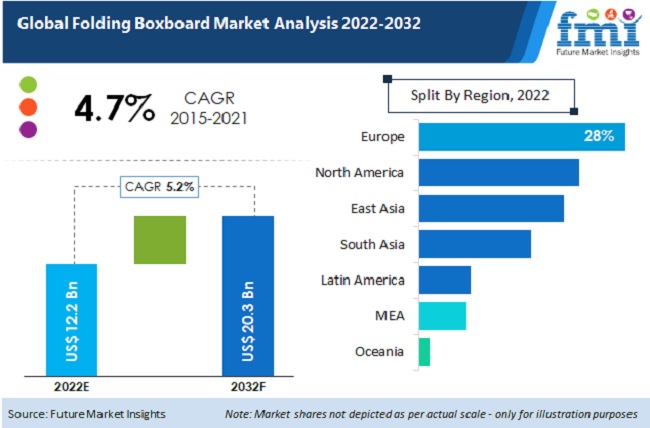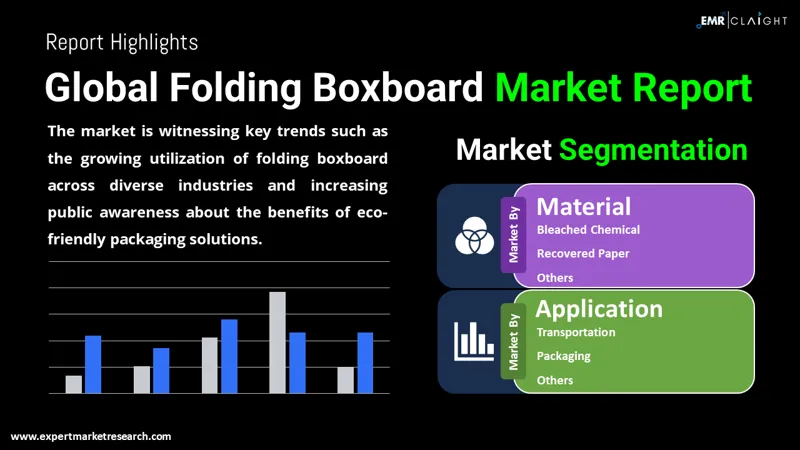Is the Folding Box Board Market Sustainable and Growing?
Overview of Folding Box Board Market
Folding box board, also known as carton board, is a packaging material widely used in various industries. It is a type of paperboard that is specifically designed for folding and is known for its strength and durability. In the packaging industry, folding box board plays a significant role in providing protection, convenience, and aesthetics to products.
The global market size of the folding box board industry has been experiencing steady growth in recent years. According to industry reports, the folding carton market is projected to grow by 2.5% in 2021 and over 5% in 2022, mainly driven by sustainability and recycling trends leading to new packaging designs. The global output of folding cartons surpassed 53 million tons in 2022, which represents a growth of over 8% from 2021. Additionally, the market worth of folding box board is expected to reach over $53 billion in 2022, showing a significant increase of more than 12% from the previous year.
Various factors contribute to the growth of the folding box board market, such as the increasing demand for sustainable packaging solutions, the rise of e-commerce, and the growing awareness of consumers regarding eco-friendly packaging. The market is witnessing substantial growth in different regions around the world, with African markets showing high growth rates from a low base and Asian markets exhibiting moderate growth rates from a higher starting point. China is a leading player in the folding box board market, with continuous afforestation efforts and a substantial forest area, ranking first globally.
Key players and suppliers in the folding box board market include International Paper Company, Metsä Board Corporation, Holmen Iggesund, and JK Paper Ltd. These companies are continuously innovating and expanding their offerings to meet the evolving demands of the packaging industry. The market is highly competitive, with companies launching new and innovative solutions to cater to various applications and end-use industries.
Folding box board finds its applications in a wide range of industries, including food and beverage, personal care, pharmaceuticals, electronic goods, and more. Its versatility and adaptability make it a preferred choice for packaging solutions in these industries. The use of folding box board offers several advantages, such as excellent printability, superior folding qualities, and environmental-friendliness.
One of the significant aspects of folding box board packaging is its sustainability. With increasing concerns about the environment, the packaging industry is shifting towards sustainable solutions. Folding box board is made primarily from renewable resources, and it is easily recyclable. Its recyclability and biodegradability make it an ideal choice for companies aiming to reduce their carbon footprint and meet their sustainability goals.
In conclusion, the folding box board market is experiencing steady growth due to the increasing demand for sustainable packaging solutions and the rise of e-commerce. It is a versatile packaging material that finds applications in various industries. The market is highly competitive, with key players continuously innovating to cater to the evolving needs of the industry. Sustainability is a significant aspect of folding box board packaging, making it an ideal choice for companies looking to adopt environmentally-friendly practices.
Market Analysis and Growth Factors
Regional Market Analysis of Folding Box Board
The folding box board market has witnessed significant growth globally, with different regions showcasing varying trends. Europe, for instance, dominates the folding box board market with a market share of about 40% in 2019. This can be attributed to the high demand for sustainable packaging solutions in the region and the increasing usage of folding box board across various industries.
On the other hand, the Asia-Pacific region is expected to witness the highest growth rate in the folding box board market. Rising income levels in this region, coupled with increased awareness of eco-friendly packaging, are driving market growth. India is the largest market for folding box board in South Asia, with an estimated market share of around 47% by the end of 2022. China, with continuous afforestation efforts and a significant forest area, leads the market in terms of production and growth.
The African markets also show promising growth rates, albeit from a low base. Asia, Europe, and North America have moderate to high growth rates, depending on their respective starting points. These regional variations in growth can be attributed to economic factors, consumer preferences, and environmental regulations.
Factors Influencing the Growth of the Folding Box Board Market
Several factors contribute to the growth and evolution of the folding box board market. One of the key drivers is the increasing demand for bio-based packaging solutions. Consumers and industries alike are becoming more conscious of the environmental impact of packaging materials. Folding box board, with its sustainable and recyclable properties, fulfills this demand and provides an eco-friendly packaging option.
Furthermore, technological advancements in printing and packaging have led to innovations in folding box board products. Improved printing techniques, designs, and finishes have enhanced the visual appeal of folding box board packaging, making it an attractive option for various industries. The rising trend of online shopping has also boosted the demand for folding box board in the e-commerce packaging sector.
Consumer preferences and demands play a crucial role in shaping the growth of the folding box board market. As consumers become more eco-conscious, they seek packaging solutions that align with their values. The sustainability and recyclability of folding box board packaging make it an ideal choice for environmentally conscious consumers.
Production Processes and Manufacturing Techniques of Folding Box Board
Folding box board is made of mechanical and chemical pulp layers, with bleached top layers coated with pigments for improved printability and visual appeal. The production process involves several steps, including pulp preparation, sheet formation, drying, coating, and finishing.
The pulp used in folding box board production can be derived from different sources, such as wood chips, recycled fibers, or agricultural residues. The pulping process involves breaking down the raw materials into fibers and removing impurities. The fibers are then mixed with water and processed further to form a pulp slurry.
Once the pulp is prepared, it is formed into sheets using a paper machine. The sheets are dried to remove excess moisture and improve strength. Coating is an essential step in folding box board production, as it enhances the printability and surface properties of the board. Various coating formulations, including pigments and binders, are applied to the board surface to achieve the desired characteristics.
After coating, the board undergoes finishing processes, such as calendaring and embossing, to further enhance its appearance and performance. These processes ensure that the folding box board meets the required standards and specifications for different applications.
Impact of Sustainability and Recycling Trends on Market Growth
The sustainability and recycling trends have a significant impact on the growth of the folding box board market. As consumers and governments prioritize environmental conservation, the demand for sustainable packaging solutions has surged. Folding box board, with its recyclable and biodegradable properties, has emerged as a preferred choice for eco-conscious consumers.
The recycling of folding box board contributes to the circular economy by reducing waste and conserving resources. The use of recovered paper materials in the production of folding box board further enhances its eco-friendly credentials. The recycling process involves collecting used folding box board, de-inking, and re-pulping it to produce recycled pulp. This pulp can then be used to manufacture new folding box board, completing the recycling loop.
The growing emphasis on sustainability and recycling has led to increased investments and innovations in the folding box board industry. Key players in the market are launching new products and expanding their production capacities to meet the rising demand for eco-friendly packaging solutions.
Growing Demand for Eco-Friendly Packaging Solutions
The demand for eco-friendly packaging solutions is on the rise, driven by changing consumer preferences and regulatory mandates. Folding box board, with its sustainable and recyclable properties, is well-positioned to cater to this demand.
The food and beverage industry is a major end-user of folding box board packaging. The use of folding box board ensures the safety and integrity of food products while minimizing their environmental impact. Other applications of folding box board include greeting cards, transportation, and various industries that require packaging solutions.
The global folding box board market is projected to grow at a steady pace in the coming years. Factors such as increasing demand for sustainable packaging, technological advancements, and changing consumer preferences are expected to drive market growth. Key players in the folding box board industry, including International Paper Company, Metsä Board Corporation, Holmen Iggesund, and JK Paper Ltd., are continuously innovating and expanding their product portfolios to meet the evolving market demands.
In summary, the folding box board market is experiencing significant growth due to factors such as the demand for sustainable packaging solutions, increasing consumer awareness, and technological advancements. Regional market trends, production processes, and the impact of sustainability and recycling trends further influence market growth. With the growing demand for eco-friendly packaging solutions, the future of the folding box board market looks promising, providing opportunities for innovation and market expansion.
Challenges and Future Trends in the Folding Box Board Industry
Challenges Faced by the Folding Box Board Industry
The folding box board industry faces several challenges that impact its growth and profitability. One of the major challenges is the increasing cost of raw materials. The production of folding box board requires high-quality raw materials such as pulp, which can be expensive. Fluctuating prices of these materials can impact the overall cost of production and profitability of the industry.
Another challenge faced by the industry is the rising competition from alternative packaging materials. With the growing demand for sustainable and eco-friendly packaging solutions, other materials such as corrugated board and flexible packaging have gained popularity. The folding box board industry needs to continuously innovate and differentiate itself to remain competitive in the market.
Additionally, the industry faces challenges related to regulations and certifications. Packaging materials, including folding box board, must comply with various regulations and certifications related to sustainability, food safety, and recycling. Meeting these requirements can be a complex process and may require additional investments in technology and equipment.
Emerging Trends in Folding Box Board Packaging
Despite the challenges, the folding box board industry is witnessing several emerging trends that are shaping the future of packaging. One of the prominent trends is the emphasis on sustainability. Consumers are increasingly demanding eco-friendly and recyclable packaging solutions. Folding box board, with its renewable and recyclable properties, is well-positioned to cater to this demand.
Another emerging trend is the use of folding box board in various applications beyond traditional packaging. This includes the use of folding box board in point-of-sale displays, promotional materials, and product inserts. This versatility of folding box board opens up new opportunities for the industry and expands its potential market.
Furthermore, digital printing technology is revolutionizing the packaging industry, including the folding box board segment. Digital printing allows for customization, shorter print runs, and faster turnaround times. This technology enables brands to create unique and eye-catching packaging designs, enhancing product visibility and shelf appeal.
Future Projections and Market Forecasts for Folding Box Board
The future of the folding box board market looks promising, with positive projections and forecasts. According to market research, the folding carton market is expected to grow by 2.5% in 2021 and over 5% in 2022, driven by sustainability and recycling trends leading to new packaging designs. The global output of folding cartons surpassed 53 million tons in 2022, representing a growth of over 8% from 2021. The market is estimated to be worth over $53 billion in 2022, a growth of more than 12% from 2021.
Medium-term forecasts predict that the global consumption of folding cartons will reach nearly 70 million tons by 2028, valued at around $215 billion. The market is expected to witness high growth rates in African markets, driven by sustainability initiatives, and moderate growth rates in Asian markets, due to increasing consumer awareness and demand for eco-friendly packaging.
Europe is expected to continue driving the folding box board market, with a significant market share of around 28% in 2022. The Chinese market for folding box board is projected to grow by 4.8% year-over-year in 2022, while Germany is expected to account for around 28% of the market share. In South Asia, India is the largest market for folding box board, with an estimated market share of around 47% by the end of 2022.
Consumer Preferences and Demands in the Packaging Sector
Consumer preferences and demands play a crucial role in shaping the folding box board industry. Consumers today are increasingly conscious of sustainability and the environmental impact of packaging. They are actively seeking products packaged in eco-friendly materials, such as folding box board, that can be recycled or composted.
Furthermore, consumers are demanding packaging that offers convenience and functionality. The packaging should be easy to open, resealable, and have features that enhance product freshness and shelf life. Folding box board packaging can meet these demands by providing structural strength, barrier properties, and customizable designs.
Innovation and Technological Advancements in Folding Box Board Products
Innovation and technological advancements are driving the evolution of folding box board products. Manufacturers are constantly investing in research and development to improve the performance and functionality of folding box board. This includes innovations in coating technologies, barrier properties, and printing techniques.
Technological advancements in printing have enabled high-quality and vibrant graphics on folding box board packaging. Digital printing offers customization options, shorter print runs, and faster turnaround times, allowing brands to create unique and visually appealing packaging designs.
Additionally, innovations in barrier coatings have expanded the range of applications for folding box board. Advanced barrier coatings can provide protection against moisture, grease, and other contaminants, making folding box board suitable for various industries, including food and beverages, healthcare, and consumer goods.
In conclusion, the folding box board industry faces challenges related to raw material costs, increasing competition, and regulatory compliance. However, emerging trends such as sustainability, digital printing, and versatile applications are shaping the future of the industry. Future projections and market forecasts indicate positive growth for the folding box board market, driven by consumer preferences and demands. Continued innovation and technological advancements in folding box board products will further enhance its market potential and position as a sustainable packaging solution.
Regional Market Share of Folding Box Board (2019)
| Region | Market Share |
|---|---|
| Europe | 40% |
| Asia-Pacific | 30% |
| North America | 20% |
| Rest of World | 10% |
Future Projections for the Folding Box Board Market
| Year | Forecasted Growth Rate |
|---|---|
| 2021 | 2.5% |
| 2022 | 5% |
| 2023 | 4.5% |
| 2024 | 3.8% |
| 2025 | 3% |
Note: The above growth rates are compound annual growth rates (CAGR)
In conclusion, folding box board is key in the packaging industry with sustainable benefits. The global market shows growth trends with eco-friendly solutions in high demand. Regional analysis, key players, and recycling trends are shaping the industry. Challenges persist, but innovation and consumer preferences drive future projections towards technological advancements. Embrace the evolving trends for a greener packaging landscape.





